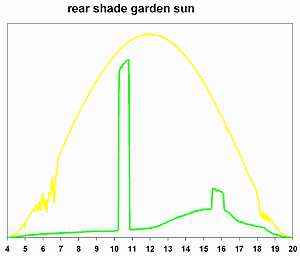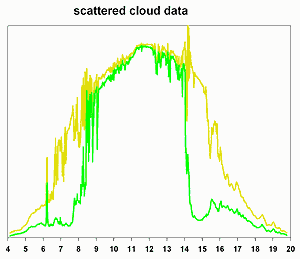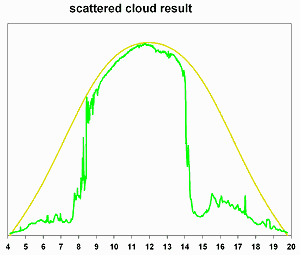My instruments were two photocells and a USB data acquisition module made by Measurement Computing. One photocell was mounted at the peak of the house roof while the other was moved to various points in the gardens, and the light of each summed over the day. On a clear day, the ratio of the two sums gives percent sunlight. I used photocells with PAR response in order to study leaf response functions, but ordinary silicon photocells will give results close enough for gardeners at lower cost.
The light around a house is more complex than all sun or all shade. The top trace at right shows several details. First, some light comes from all over the sky, even on a cloudless day. Between 1000 and 1100 solar time, the garden is in direct sun, but the level is reduced because only a small portion of that sky light is visible at the garden. In the afternoon, the garden level increases because the white house siding that surrounds it is in sun even though the garden itself isn't. About 1600, there is reflection from a large window. And, when the sun is near the horizon, it is blocked more by air haze than at the zenith.
Of course, not all days are cloudless. The method I found most reliable to compensate for scattered clouds used 4 steps:
- scale the sunlight measured on a clear day to the day length of the current measurement,
- when measured garden sun is greater than 80% of measured roof sun, multiply garden sun by the ratio of reference roof sun to measured roof sun to compensate for the light absorbed by the cloud,
- when garden sun is less than 80% of roof sun, use the level measured; light received from all over the sky is affected very little by a local cloud,
- garden percent sun is the ratio of the result of 2&3 to reference sun.
At bottom is the result of a measurement on a 3 m grid over all my gardens, after processing by a contour line app.



